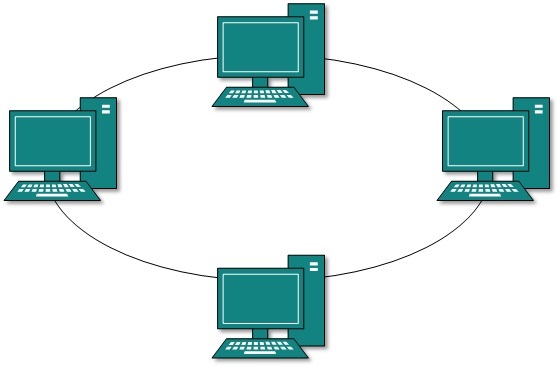Network Topology:
A network consists of two or more computers that are linked to share resources (such as printers and CD-ROMs), exchange files, or allow electronic communications. Computers in a network can be connected through cables, telephone lines, radio waves, satellites or infrared light beams.
The term “topology” refers to the design of devices connected in a network. The topology of the network defines the computers in which the computers are linked to the network and create networks. computers are connected to each other and create a “Topology”. This article presents the different standard topologies of computer networks:
- Bus
- Ring
- Star
- Tree
- Mesh
Bus Topology:

According to this scheme, all computers are connected to one common cable. General cable is called the backbone.
The backbone network functions as a shared means of communication that the devices connect to an interface connector. A device that wants to communicate with another device on the network sends a broadcast message to the cable that all other devices see, but only the intended recipient actually accepts and processes the message.
The baseline is mainly copper-plated, dielectric coatings, and metallic sheath wires. Such cables are called coaxial cables.
Advantages:
- Extend network, ie. It’s easy to connect to a computer.
- Use a lower cable than other topology, cheap
Disadvantages:
- Increase in the number of computers will decrease speed.
- The whole network is in operation when the baseline is damaged
Star topology:

Under this scheme, computers are connected to a common node. A star topology is designed with each node (file server, workstations and peripherals) connected directly to a hub or central network hub.
The information from one computer will be sent to the address server via a node. In this sense, the node (ie, based device) controls the entire network. Computers are usually connected to a UTP-cable (unshielded twisted pair cable).
Advantages:
- It is easy to assemble and connect the network.
- Whenever the network of a computer or the cable connected to it is damaged, the entire network will not escape.
- Determine network faults, easy segregation of parts, etc.
Disadvantages:
- The bus topology needs longer cables.
- When the device at the node is damaged, the entire network will exit the prototype.
- The network cost is higher than the bus topology depending on the device on the node
Ring Topology:

According to this scheme, each computer has two neighbours. Data from one computer will go through the “ring” until it reaches the computers they are addressing. This will allow all intermediate computers to be transmitted. Therefore, if the network is damaged in any part of the network, the network is entirely out of command.
Advantages:
- The growth of the system has a minimal impact on performance
- All stations have equal access
- The network does not fail even when a link between two nodes is broken.
Disadvantages:
- The most expensive topology
- The failure of a computer can affect others
- Complex
Mesh Topology:

According to this scheme, every computer is connected to each other by telephone. That’s why it’s called a mesh.
There are several possible routes for data transfer from one computer to another. First, the shortest available route is automatically selected. If the route is not available, choose another route. This is different from other topologies. If all computers and all cables are not damaged, then the information will be in the place where they are addressed.
Advantages:
- The system offers increased redundancy and reliability, as well as easy troubleshooting.
- Data transfer is faster.
- Adding and removing nodes is easy.
Disadvantages:
- The system is expensive to install because it uses a lot of cabling.
Tree topology:

This topology consists of a Star Circuit group linked to each other. Bus and Star topology hybrid (union). The base line connecting Star topologies is called trunk. Tree topology is more convenient than any single Bus and single Star schemes to further expand any network.
Advantages:
- Point to point wiring for individual segments.
- The network does not fail even when a link between two nodes is broken.
- Supported by several hardware and software providers
Disadvantages:
- Overall length of each segment is limited by the type of cabling used.
- If the backbone line breaks, the entire segment goes down





